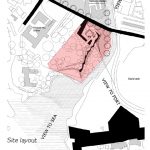
By Rajiv Wanasundera
In January 1958 a young Danish man in his twenties gets off a ship in Colombo. He is an architect; he is devastatingly handsome and has a wry sense of humour. He lives in Sri Lanka for almost a decade, working in Kandy, then Colombo, traveling its length and breadth. In 1967 he abruptly returns to Europe, leaving behind a number of ground breaking modern buildings that continue to influence and inspire to this day. He returns to Sri Lanka at the age of fifty, for another seven years. His time on the island leaves an indelible impression and he considers these years as being the happiest of his life.
Ulrik Plesner, now 82 and living in Israel, has published a memoir titled ‘In Situ’ – an account of his years in Sri Lanka. It details his collaboration with Minnette de Silva and Geoffrey Bawa, his friendships with Ena de Silva, Barbara Sansoni and Laki Senanayake, and the remarkable contribution he made to Sri Lankan architecture. The book is a narrative of his time on the island, interspersed with family history, sketches, newspaper clippings, architectural drawings and photographs. There are chapters on Minnette and Geoffrey, Ena and Barbara; others on his work and teaching and a final section covering his second act in Sri Lanka as Director of the Mahaweli Architecture Unit.
The language in the early chapters is so evocative and elegant that it is hard to resist being seduced by the imagery. Plesner describes his initial years in Sri Lanka as a “state of grace,” and that comes through strongly in the writing as well. Describing one of Minnette’s early houses, he writes: “it was like a poem in breeze and air surrounded by a garden of giant leaves.” Metaphors like this is abound in the book, giving it the feel of a magical realist novel. However, the account of 1980s is much more cut and dried. There are descriptions of meetings with senior politicians and the logistical challenges involved in managing a fast-paced development project.
Plesner’s contribution to modern Sri Lankan architecture cannot be disputed. He worked alongside two of the most influential Sri Lankan Architects of the 20th century. His collaboration with Geoffrey Bawa produced many remarkable buildings which served as a springboard to Bawa’s future success. He joined Barbara Sansoni in her endeavourto document the historic vernacular building tradition of Sri Lanka and enlisted like-minded students to join the effort by sharing his knowledge of measuring existing buildings. He helped mould a generation of young Sri Lankan architects by teaching at the newly established architecture school in Katubedde. Donald Friend in his diaries remarks: “He [Ulrik] believes one can do anything, so one does.”
The projects Plesner worked on in the 1960s include some of the most significant buildings built in post-independence Sri Lanka. They include the Sansoni Annex, Bandarawela Chapel and the house at Polontalawa. Plesner takes great care to present the work done by Bawa and himself during this period as the product of “an exclusive and seamless partnership”. He writes that, “there was absolute understanding about where we were going and what we were trying to achieve and what was the purpose of it all, and we urged each other on like two people doing a beautiful puzzle together.” According to Plesner, it was his technical proficiency and knowledge of construction that shaped Bawa’s raw talent. It allowed Bawa to move beyond being a dilettante with a passion for gardening and become a great architect. There is no doubt their collaboration was fruitful and it laid the groundwork for Geoffrey Bawa’s long and productive career. However, Plesner’s role as an equal partner in Bawa’s office is a contentious one and continues to be debated by scholars and Bawa’s later associates. Plesner does not expand on what he learned from Bawa, other than to say that “what one lacked, the other had, as if we had emptied the contents of our pockets on the table and found that together we had a complete set of tools.”
Plesner is to be commended for publishing this work of personal history. To read the text is to get an intimate – though controlled – glimpse into a significant period in Plesner’s life. He is candid, always entertaining and willing to admit to some of his own faults and weaknesses. He is charming and seductive at most times, occasionally selfish and infuriating, and sometimes contradictory.
‘In Situ’ is an important contribution to architectural scholarship in Sri Lanka. It is a wonderfully entertaining and beautifully written account of a time when a truly modern Sri Lankan architectural identity came into being.











